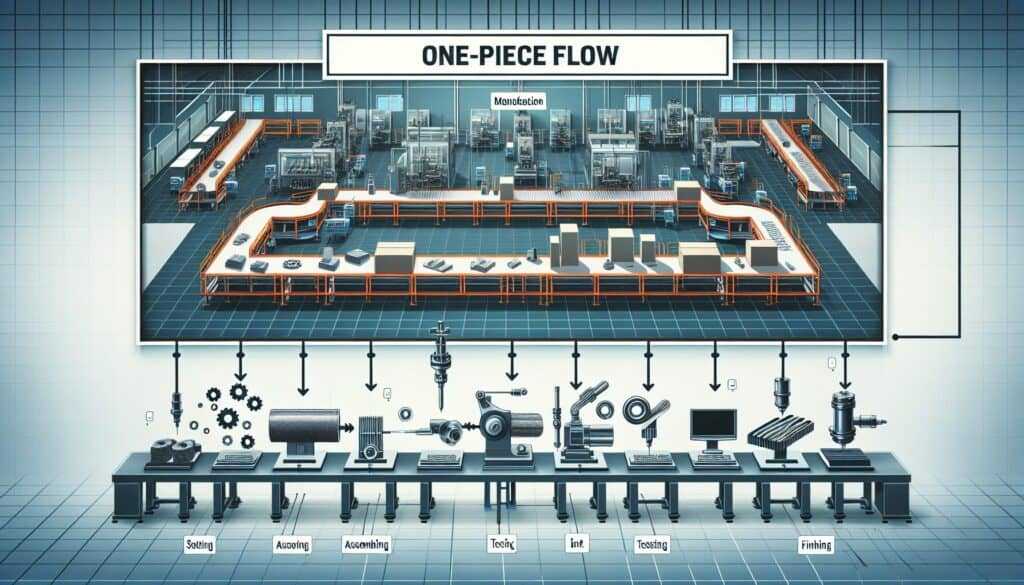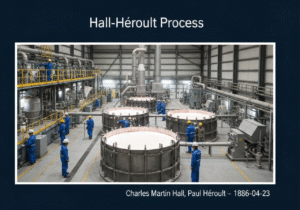Producir y mover un artículo cada vez (o un lote muy pequeño) entre operaciones, en lugar de procesar en grandes lotes.
- Metodologías: Clientes y marketing, Economía, Lean Sigma, Fabricación, Gestión de proyectos, Calidad
Flujo de una pieza

Flujo de una pieza
- Mejora continua, Justo a tiempo (JIT), Manufactura esbelta, Producción ajustada, Optimización de procesos, Eficacia de la producción, Gestión de calidad, Mapeo del flujo de valor, Estrategias de eliminación de residuos
Objetivo:
Cómo se utiliza:
- Dispone los puestos de trabajo en secuencia, lo que permite que una sola unidad pase por todas las fases del proceso sin acumular trabajo en curso (WIP) ni retrasos. Se asocia estrechamente con el Just-In-Time y la fabricación celular.
Ventajas
- Reduce el inventario WIP, los plazos de entrega y las necesidades de espacio; mejora la calidad al permitir una rápida retroalimentación y detección de defectos; aumenta la flexibilidad y la capacidad de respuesta a la demanda de los clientes; simplifica el control de la producción.
Contras
- Requiere procesos estables y fiables con un alto tiempo de actividad y una calidad constante; puede ser difícil equilibrar las cargas de trabajo en todas las operaciones; puede requerir cambios significativos en el diseño y formación cruzada de los operarios; menos adecuado para procesos con tiempos de preparación muy largos.
Categorías:
- Lean Sigma, Fabricación
Ideal para:
- Crear un sistema de producción altamente eficiente, continuo y con capacidad de respuesta, especialmente en entornos con una gran variedad de productos.
One-Piece Flow is commonly employed in industries such as automotive manufacturing, electronics, and consumer goods, where speed and efficiency are paramount due to high competition and rapid market changes. This methodology is particularly effective during assembly processes and demands a high degree of coordination among teams, prompting cross-functional collaboration between engineers, designers, and production staff to optimize workflow. Initiated by lean practitioners or process improvement teams, it often begins in pilot projects or specific product lines, enabling organizations to assess feasibility before a full-scale rollout. Implementation requires a thorough understanding of product variations and customer demand patterns to effectively operate the flow with minimal disruption. Techniques such as Value Stream Mapping may be utilized to identify bottlenecks and enhance layout design for improved flow, directly influencing cycle times and inventory levels. Industries employing One-Piece Flow benefit from enhanced customer satisfaction due to reduced lead times and improved responsiveness to shifts in demand, making it especially suited for environments where customization is valued. The integration of technology, like real-time data tracking systems, reinforces this methodology by providing visibility into each step of the process, facilitating quicker adjustments to production schedules when necessary. Training and involvement of all stakeholders, including shop floor workers and management, are crucial in sustaining these improvements, creating a culture that supports continuous improvement and innovation throughout the production cycle.
Pasos clave de esta metodología
- Design the layout for workstations in a linear sequence based on the product flow.
- Implement standardized work procedures at each workstation to ensure consistency.
- Train operators on multi-tasking to reduce dependency on specific roles.
- Establish pull signals to trigger production based on current demand.
- Monitor workflow continuously to identify and eliminate bottlenecks.
- Integrate quality control checks at each workstation for immediate feedback.
- Encourage cross-functional collaboration to address issues as they arise.
- Utilize visual management tools for real-time tracking of production progress.
- Conduct regular assessments to optimize the flow and adjust processes as necessary.
Consejos profesionales
- Conduct regular process mapping sessions to identify and eliminate bottlenecks within the one-piece flow, ensuring optimal alignment of workstations.
- Implement real-time data monitoring to analyze cycle times and adjust workflows dynamically, enhancing responsiveness to demand fluctuations.
- Utilize standardized work instructions across all stations, fostering consistency and enabling rapid training of personnel to maintain flow integrity.
Leer y comparar varias metodologías, recomendamos el
> Amplio repositorio de metodologías <
junto con otras más de 400 metodologías.
Sus comentarios sobre esta metodología o información adicional son bienvenidos en la dirección sección de comentarios ↓ , así como cualquier idea o enlace relacionado con la ingeniería.
Contexto histórico
1890
1924
1930
1940
1950
1950
1958
1886-04-23
1897
1930
1940
1949
1950
1950
1960
(si se desconoce la fecha o no es relevante, por ejemplo "mecánica de fluidos", se ofrece una estimación redondeada de su notable aparición)















Publicaciones relacionadas
Cuestionarios sobre molestias musculoesqueléticas
Pruebas multivariantes (MVT)
Análisis de regresión múltiple
Sistemas de captura de movimiento
Método MoSCoW
Prueba de la mediana de Mood